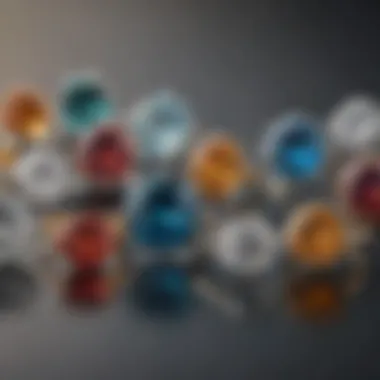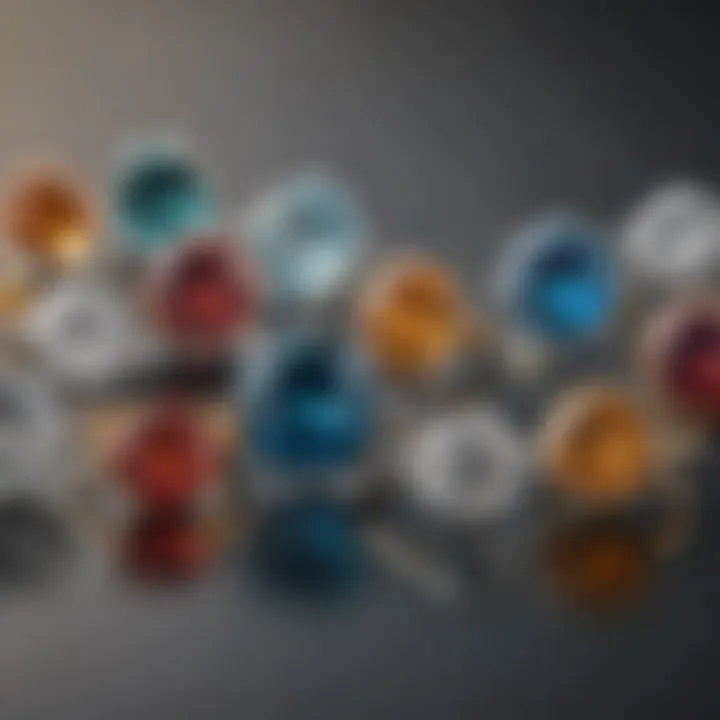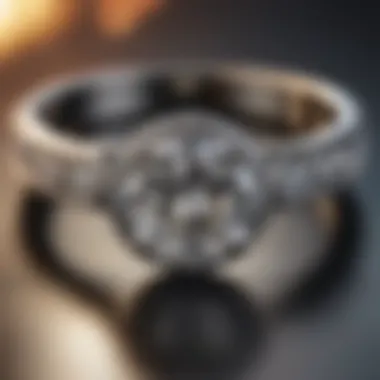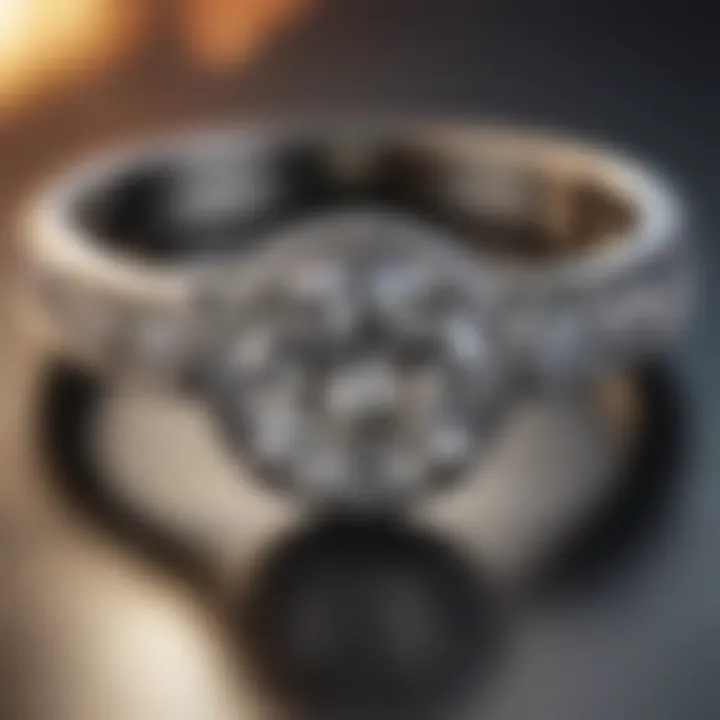Engagement Ring Ordering Timeline Explained


Intro
Navigating the intricate path of selecting an engagement ring can be a daunting experience, especially with countless choices and considerations at every turn. Whether it's about the choice of gemstone, the design of the setting, or the reputation of the jeweler, every decision weighs heavily on the timeline for completing this crucial purchase. Therefore, understanding the details and timelines involved is essential not only for making the right investment but also for ensuring that you are fully prepared for such a significant moment in your life.
Gemstone Overview
Definition of Gemstones
At its core, a gemstone is a piece of mineral crystal or rock that is cut, polished, and used in jewelry or adornments. The allure of gemstones goes beyond their visual appeal; they often carry qualities that resonate deeply with people, from their inherent beauty to their perceived metaphysical properties. The classification of gemstones includes precious stones, such as diamonds, rubies, and emeralds, which are renowned for their rarity and elegance, as well as semi-precious stones, like amethyst and garnet, that bring charm and vibrance to any piece.
Classification of Gemstones
When considering engagement rings, the classification of a gemstone plays an important part in the timeline for ordering. Here’s how they can be categorized:
- Natural Gemstones: Formed through natural geological processes, these stones are unmodified, except for the cutting and polishing.
- Synthetic Gemstones: Created in laboratories to mimic natural gems, they often carry a lower price point while maintaining a similar appearance.
- Enhanced Gemstones: Natural stones that have undergone treatments to improve their color or clarity. These enhancements can affect both the quality and the price, subsequently influencing timeline commitments.
Understanding these distinctions can help buyers make informed decisions while sorting through the options.
Important Note: Selecting the right gemstone can significantly influence the ordering process. Some stones may require longer sourcing times due to rarity.
Historical Significance
Origins of Gemstone Use
The origins of gemstone use can be traced back thousands of years, where they were cherished not just for their beauty but for their beliefs and symbolisms. In ancient cultures, such as the Egyptians, gemstones were thought to provide protection in the afterlife, while in others, such as the Greeks, they were attributed unique powers. All through history, these beliefs have seduced people into purchasing gemstones, effectively evolving the timeline for acquiring engagement rings into a ritualistic journey.
Cultural Insights: Gemstones in Ancient Civilizations
Different civilizations have had their take on gemstones through the ages. For instance, in India, the belief in the astrological properties of certain stones has created a market for specific gems corresponding to zodiac signs. Similarly, ancient Romans valued gemstones for their beauty and believed that wearing them provided status and wealth. Such cultural ties and beliefs all contribute to how and why individuals choose their gemstones today, further affecting the time needed to order custom pieces.
In essence, comprehending the historical significance and classifications of gemstones aids prospective buyers in making educated choices, ensuring that the engagement ring selection is not only timely but also meaningful.
Intro to Engagement Rings
Engagement rings hold a special place in both romantic gestures and cultural traditions. They serve as tangible symbols of commitment, marking a significant milestone in many relationships. For those contemplating marriage, selecting the perfect ring is often one of the first steps in the journey—a task that's both thrilling and overwhelming. Understanding the nuances involved in ordering an engagement ring is crucial, as it can save you time, effort, and possibly money in the long run.
When it comes to these rings, each one tells a story, whether it reflects personal style, familial significance, or cultural heritage. The possibilities are extensive, ranging from classic solitaire diamonds to unconventional colored gemstones. Many people overlook this aspect, but the ring can be a true representation of shared histories and future aspirations.
Cultural Significance
Engagement rings are steeped in tradition, varying widely across cultures and regions. In Western societies, the diamond engagement ring has become the norm, often perceived as a standard that denotes financial stability and emotional depth. However, in other cultures, different materials or designs may be preferred. For instance, in some African cultures, the use of gold is emphasized, while in certain Indian traditions, elaborate gold rings may incorporate intricate designs reflecting the bride's family lineage.
Furthermore, the practice of wearing engagement rings on the fourth finger of the left hand is rooted in the belief that this finger contains the "vena amoris," thought to connect directly to the heart. This illustrates that, while the love shared is universal, the specific customs surrounding engagement rings can vary greatly, adding layers of depth and meaning.
Types of Engagement Rings
When diving into the world of engagement rings, it is essential to understand the different types available to ensure that the final choice aligns with both preference and occasion.
- Solitaire Rings: The classic option, featuring a single gemstone—typically a diamond—set against a simple band.
- Halo Rings: These showcase a central stone surrounded by smaller stones, enhancing the overall sparkle.
- Three-Stone Rings: Often symbolic of the past, present, and future, these feature three stones that can vary in size and shape.
- Vintage and Antique Rings: Carrying unique patterns and historical significance, these rings often appeal to those who value craftsmanship.
- Colored Gemstone Rings: For those who want to break away from tradition, options like emeralds, sapphires, or rubies offer vibrant alternatives.
Each type comes with its considerations, affecting not only appearance but also price and availability. The choice here can significantly impact the overall experience of purchasing an engagement ring, as certain styles may require longer production times or involves additional design complexities.
In summary, an understanding of the significance and types of engagement rings lays the groundwork for making informed choices throughout the entire ordering process. Recognizing this can transform the often stressful experience of selecting a ring into a rewarding journey, ensuring not just a beautiful piece of jewelry but also a meaningful symbol of love.
Factors Affecting Ordering Time
When it comes to ordering an engagement ring, various elements play a significant role in determining how long the entire process takes. These factors can profoundly influence the timeline, from the initial concept to the final product while ensuring that the ring is not only beautiful but also meaningful.
In this section, we'll take a closer look at three main components that can affect the ordering time: design customization, material sourcing, and artisan skill levels. Understanding these elements can help buyers make informed decisions and set realistic expectations as they navigate the intricate jewelry landscape.
Design Customization
Customizing an engagement ring is often a personal journey, allowing couples to create a piece that resonates with their unique love story. The decision to customize can introduce additional lead times, as each aspect of the ring is tailored to the buyer's specifications.
Selecting Gemstones
Selecting gemstones is perhaps one of the most exciting parts in the design process. The choice of stone not only affects the ring’s aesthetic but also contributes to its overall value. Particularly, diamonds tend to be the go-to choice—known for their brilliance and durability. However, other options like sapphires or emeralds can be eye-catching and symbolize specific traits, like loyalty or growth.
- Key Characteristic: The durability makes diamonds a popular choice.
- Unique Feature: Each gemstone possesses a unique color and clarity level.
- Advantages: Customization offers you the chance to choose something that speaks to you.
- Disadvantages: Availability can greatly affect how long it takes to acquire your desired stone, particularly in the case of bespoke or rare gems.
Ring Style Variations


The style of the ring can also greatly impact the timeline. From classic solitaires to intricate vintage designs, these variations might entail different production times. An elaborate style not only requires more time during manufacturing but may require specific materials that could complicate sourcing.
- Key Characteristic: The variation allows for personal expression.
- Unique Feature: Some styles may need additional detailing that extends the time.
- Advantages: A well-chosen style can make the ring truly unforgettable.
- Disadvantages: More elaborate designs usually mean longer waiting periods.
Engraving Options
Engraving is one of those details that can add a sentimental touch to an engagement ring, turning it from a mere accessory to a cherished symbol of love. You can personalize it with initials, dates, or phrases.
- Key Characteristic: Personalization adds emotional value.
- Unique Feature: Each engraving is unique, often designed to reflect the couple’s ideals.
- Advantages: It infuses a personal touch that makes the ring special.
- Disadvantages: Depending on the complexity, engraving can add extra time to the overall creation process.
Material Sourcing
The sourcing of materials also has a big influence on how long it takes to get your ring. Jewelers must consider various factors in this stage that can lengthen production times.
Metal Types
Different metals offer different aesthetics, durability, and price points. Choosing between platinum, white gold, yellow gold, or rose gold not only affects the ring’s appearance but also its longevity and care requirements.
- Key Characteristic: Each metal brings its own set of qualities.
- Unique Feature: Platinum is hypoallergenic, making it a great choice for sensitive skin.
- Advantages: Knowing metal types helps prioritize your search.
- Disadvantages: Some metals can be difficult to source or require extra time for crafting.
Gemstone Availability
The availability of particular gemstones can easily delay the ring’s creation. Some stones, like diamonds, are often readily available, while others may have seasonal peaks or be harder to obtain.
- Key Characteristic: The market demand fluctuates based on various trends.
- Unique Feature: Certain gems can fetch higher prices due to rarity.
- Advantages: A well-chosen gemstone can enhance the ring’s character.
- Disadvantages: Limited availability can push estimated delivery dates further.
Ethical Sourcing Considerations
In today’s market—a growing awareness of ethical sourcing practices has emerged. Buyers might seek out vendors who can guarantee that their materials are conflict-free or sourced through environmentally sustainable practices.
- Key Characteristic: Ethical sourcing adds a layer of responsibility.
- Unique Feature: It enhances the ring’s narrative beyond mere aesthetics.
- Advantages: It aligns your purchase with personal values.
- Disadvantages: It may limit options and extend timelines.
Artisan Skill Levels
The skills and experience of the jeweler can markedly affect how quickly a ring design comes to life. Taking the time to find a skilled artisan is important in ensuring high quality and design precision.
Experience of Jewelers
Working with seasoned jewelers often means that your design is in good hands. Their expertise can streamline the communication process, allowing for faster execution of ideas.
- Key Characteristic: Experienced jewelers often have a diverse portfolio.
- Unique Feature: Their established techniques can significantly reduce errors during production.
- Advantages: They can often provide faster delivery without sacrificing quality.
- Disadvantages: Highly sought-after artisans might have longer waiting lists.
Complexity of Design
As designs become more complicated, the time required to construct the ring increases. Intricate designs often call for more labor and attention to detail.
- Key Characteristic: Complexity adds visual beauty to the piece.
- Unique Feature: Each detailed element requires meticulous execution.
- Advantages: Unique designs offer a heightened sense of individuality.
- Disadvantages: The timeline can stretch considerably with higher complexities.
Understanding these factors gives you the power to make informed decisions and manage your expectations effectively as you set out to order an engagement ring. Knowing that a little patience can lead to something timeless may ease the stress of the process.
The Ordering Process
Engaging with the intricacies of ordering an engagement ring is akin to embarking on a journey. This process isn't merely about selecting a ring; it's about crafting a symbol of love that resonates personally and emotionally. Each step adds layers to both the ring's significance and the buyer's experience. This section details the phases involved, from initial consultations to production, ensuring prospective buyers grasp what awaits them.
Initial Consultation
The initial consultation acts as the cornerstone of the entire ordering process. This is where ideas start to take shape and a vision begins to form. The importance of this stage cannot be overstated, as it sets the tone for everything that follows.
Discussing Preferences
Discussing preferences during the initial consultation gives a buyer the chance to lay their cards on the table. This part is all about articulating desires—everything from style and color to gemstone shapes. This back-and-forth really pulls at the specific threads of taste, ensuring that the outcome aligns with personal aesthetics. The key characteristic of this aspect is the deep dive into personal styles. It allows the client to see their own vision emerge, which is often a thrilling experience. Consequently, the beneficial nature of discussing preferences ensures that the final design is a genuine reflection of the recipient's tastes, making it all the more special.
However, one potential drawback is that varying opinions during these discussions can lead to confusion or indecision. Clients should be mindful of this and come prepared to discuss, not just what they like, but also what resonates with their partner.
Exploring Budget
Exploring the budget is a nervous yet vital component. It's no secret that engagement rings can come with hefty price tags. At this stage, navigating the financial landscape can clarify what’s feasible while avoiding unwelcomed surprises down the line. This aspect shines with its transparency—laying out finances allows for smoother negotiations and better decisions. A crucial characteristic here is that it encourages informed choices while keeping emotional exuberance in check.
One unique feature of discussing budget is that it helps to strike a balance between desire and reality. On the downside, overly strict budgeting may narrow options too much, leading to a compromised vision. It's best if clients maintain a bit of flexibility while still steering clear of financial pitfalls.
Design Approval


Once preferences and budgets have been discussed, the process moves on to approving designs. This phase transforms abstract ideas into tangible plans, fostering excitement and anticipation for what’s to come.
Renderings and Sketches
Renderings and sketches serve as visual representations of each discussed concept. They are instrumental in solidifying the client’s thoughts into a coherent format. This stage stands out due to its ability to visualize ideas ahead of actual production. Many find reassurance in seeing a physical draft of their aspirations, which can lead to greater confidence in their choices. This is crucial for narrowing down aspects such as gemstone placement and ring size.
A minor downside could be that sketches might not always reflect the final product perfectly, often leading to moments of disappointment if expectations aren't managed carefully.
Client Feedback
Client feedback is vital for ensuring that the design aligns with the envisioned outcome. Open channels of communication allow jewelers to amend designs based on the client's preferences, creating an increasingly collaborative environment. The hallmark of this process is iterativity; it’s a dynamic cycle of feedback and adjustment that fosters a sense of ownership in the buyer. They can refine their ideas further, bringing them closer to the final result.
The only drawback can be that extensive feedback loops might prolong the timeline, especially if many rounds of changes are requested. Therefore, clients should aim for clarity in their feedback to streamline this stage.
Production Phases
Production phases mark the transition from design to reality, encapsulating the meticulous craftsmanship that leads to the final ring.
Creating the Setting
Creating the setting is where artistry comes into play. The jeweler begins manifesting the design into an actual piece—a meticulous task that requires precision and skill. This stage is crucial because the setting lays the groundwork for how the gemstone will be displayed. The defining characteristic here is the opportunity for customization, allowing different styles ranging from vintage to modern.
However, the downfall may come if craftsmanship doesn’t meet expectations, which can lead to additional time spent rectifying errors before proceeding to the next steps.
Setting the Gemstone
The process of setting the gemstone transforms a mere setting into a piece that glistens with value. This stage is significant as it breathes life into a static creation. It requires an expert hand to ensure that the stone is securely placed and highlights its iridescence beautifully. A feature of this stage is that it demands close attention to detail; even a slight miscalculation can have lasting repercussions on the ring's aesthetics.
Nevertheless, if done with care, this phase builds a solid foundation for durability, making the ring not only visually appealing but also robust over time.
Finishing Touches
As the final phase in production, finishing touches refine and polish the piece to perfection. It encapsulates everything—cleaning, polishing, and ensuring quality control. This part is essential as it ultimately showcases the ring’s beauty, ensuring it sparkles just right. The characteristic of this stage is its ability to transform a rough product into a stunning symbol of commitment. After all this work, any neglect in finishing can tarnish the work done so far.
Yet, while it might seem minor, rushing through this stage can diminish the visual appeal—a balance of efficiency and thoroughness is key here.
Engaging in the ordering process with an understanding of its intricacies allows buyers to navigate each phase with knowledge and confidence. Through clear communication, careful budgeting, and a focus on detail, one can ensure that their chosen ring transcends a mere ornament—becoming a lasting legacy of affection.
Timeframes by Ring Type
When it comes to ordering an engagement ring, understanding the different timeframes based on ring type is vital. Each type of ring – whether ready-made, semi-custom, or fully customized – comes with its own set of timelines due to various factors like design intricacies, materials used, and the overall production process. Recognizing these differences not only helps buyers plan effectively but also ensures they don’t end up scrambling at the last minute when a proposal is on the horizon.
As you delve into these categories, it’s essential to think about your individual preferences, the uniqueness you wish to capture, and the time you have before the big moment. The more informed you are about each type’s timeframe, the smoother the ordering experience will be.
Ready-Made Rings
Ready-made rings are the quickest option to acquire, often found in various jewellery stores. These rings are pre-manufactured and can be picked up almost immediately, sometimes even on the same day.
One of the advantages of choosing a ready-made ring is the vast selection available for different tastes and budgets. Usually, the time from decision to acquisition could be less than a week. However, there are drawbacks too. Many ready-made rings may lack customization options, limiting personal touch.
If time is of the essence, this might be the way to go. Just ensure the settings, gemstones, and sizes are to your liking. Otherwise, you might find yourself looking for an upgrade sooner than expected.
Semi-Custom Options
Semi-custom rings offer a blend of convenience and personalization. This option allows you to choose a pre-existing design and make specific modifications – like changing the stone or adjusting the metal type. The production timeline for semi-custom rings typically spans several weeks, depending on the jeweler's workflow and the complexities of your changes.
Here are some points to consider:
- Timeframe: Generally takes about 4 to 6 weeks.
- Advantages: You get a more unique piece without waiting for an extended period, and you can often see a rendering before the final production.
- Limitations: While it’s more personalized than ready-made, it still has some constraints compared to fully custom options.
This route tends to suit those who want a hint of personal flair without straying too far into longer wait times.
Fully Customized Designs
Opting for a fully customized design means embarking on a more extended journey, which usually lasts anywhere from 6 to 12 weeks or more. This option gives you the freedom to bring your wildest dreams to life, from the tiniest design element to the selection of rare gemstones.
While this path allows for a completely unique outcome, it comes with several considerations:
- Timeframe: Needs ample planning; expect delays if changes are needed at various stages.
- Involvement: You’ll likely spend significant time working with your jeweler on design sketches and material sourcing.
- Benefits: The satisfaction of having a one-of-a-kind piece tailored just for you can outweigh the longer wait.
However, be prepared for a journey that requires patience and a willingness to communicate effectively with your jeweler. The end product would not just be a ring; it would tell your distinct story.


Ultimately, your choice will reflect both your vision and your time constraints. Knowing the implications of each option helps in assuring that your ring aligns closely with your desires while fitting neatly into your schedule.
Logistical Constraints
When it comes to ordering an engagement ring, the subtleties of logistical constraints can easily get brushed aside. But these constraints are, in fact, the unsung heroes of the entire process. They're crucial because they shape not only how long it'll tale to get the ring but also how smooth that journey will be. Ignoring these constraints could lead to unforeseen delays and frustration.
Vendor Availability
The availability of vendors is a key player in the logistical landscape. Imagine you find the perfect jeweler who specializes in the type of custom design you have in mind. However, if they're already booked solid with an influx of orders, you might need to wait longer than anticipated just to get your foot in the door.
It's vital to research potential vendors before you get too deep into the planning process. Factors like their reputation, previous customer reviews, and especially their upcoming schedule can greatly impact your timeline. A good jeweler will usually have a schedule available on their website, which typically includes current wait times.
- Ask questions: What is their average turnaround time for custom orders? Are there specific times in the year when they might be busier than usual, like around Valentine's Day or Christmas?
- Consider consultations: Sometimes, a brief consultation can provide a wealth of information about both the process and the jeweler's capacity.
Effectively managing vendor availability makes for a smoother journey from design to delivery.
Supply Chain Delays
Supply chain delays can be quite the monkey wrench in the gears of your engagement ring metn. They arise from a host of issues, such as transportation problems, shortages of materials, or even disruptions due to global events. These hiccups might mean waiting extra weeks or sometimes even months, depending on how severe the delays are.
Given that each ring often requires a mix of specialized materials, unanticipated delays on any front can derail your plans. Consider these factors:
- Material sourcing: Certain gemstones or metals might not be readily available and could take time to acquire. For example, if you have your heart set on a rare type of diamond, it might take longer to find one that meets your criteria.
- Seasonal factors: Various factors, including weather or local holidays, can also impact delivery timelines. In regions where severe weather is common, transportation delays can become all the more probable.
Being proactive about supply chain considerations can save a great deal of hassle. Consider keeping a backup plan in place, perhaps by selecting alternate materials or designs that could be executed more promptly.
Focus on understanding both vendor availability and supply chain issues. Knowledge will allow you to manage expectations and adapt as necessary throughout this important process.
Enhancing the Ordering Experience
Ordering an engagement ring is more than just a transaction; it’s a deeply personal journey that can be excitedly intimidating. The way you enhance this experience can make a world of difference. A positive interaction with the jeweler not only smooths the road to getting the perfect ring but also enriches the emotional investment in the process.
Effective Communication with Jewelers
When diving into the ring ordering process, effective communication with jewelers stands as a cornerstone. It's akin to building a bridge between imagination and reality. When discussing your preferences, clarity matters. Start by articulating what you envision, whether it’s a certain stone or a specific metal. Sharing inspiration images can nail down the aesthetic direction very quickly. Jewelers appreciate when you come prepared.
Furthermore, don’t shy away from asking questions. Queries about craftsmanship, material sourcing, and design timelines raise your knowledge and boost your confidence in the decision-making process. Sometimes, what’s down as an ideal configuration on paper might not work because of material limitations or the jeweler's capabilities. Knowing this ahead of time saves headaches down the line.
It also benefits the jeweler — after all, they want to make your vision come to life. A straightforward discussion cranks up the chances of creating a ring that doesn't just meet your expectations but surpasses them.
Setting Realistic Expectations
Now, no one wants to rain on a parade, but setting realistic expectations is crucial. The excitement of ordering an engagement ring can sometimes cloud judgment. It’s tempting to think everything will fall into place like clockwork. Unfortunately, that isn’t always the case.
First off, timelines can vary quite a bit depending on multiple factors we previously discussed, such as customization levels and materials. For instance, a fully customized design may take several weeks to months, whereas a ready-made ring can potentially be purchased the same day. Knowing the average timeframes keeps the anticipation in check without the frustration.
Moreover, the quality of the final product often takes time. A rushed design might lead to compromises. So, instead of aiming for an unrealistic timeline that would set both parties up for disappointment, it's far smarter to have an open dialogue about what is feasible.
Remember, patience is not just a virtue; it’s a necessity in the realm of fine jewelry making. Each ring goes through rigorous stages — from design to production — which shouldn’t be rushed. Greater quality typically emerges from a longer timeline.
Key Insight: Enhancing the ordering experience revolves around communication and realistic perspectives. The end result will be a testament to the thoughtful planning that went into it.
By approaching the order with clear communication and realistic expectations, you’ll not only foster a more enjoyable process but also cultivate a relationship with your jeweler. The final product becomes a symbol enriched with meaning, crafted through a thoughtful exchange.
End
The significance of the conclusion in this article cannot be overstated. It serves as the crucial wrap-up, synthesizing the various elements discussed throughout the piece on ordering an engagement ring. In a world replete with choices, understanding the timeline for this poignant decision is essential. Once the reader reaches the conclusion, they should carry a sense of clarity and preparedness about the entire process—knowing when to start, what factors influence timelines, and how to effectively communicate with jewelers.
Recap of Key Points
As we look back, several pivotal aspects were covered:
- Cultural Significance: Rings symbolize commitment, answer a deep cultural quest for meaning.
- Factors Influencing Time: Design customization, material sourcing, and artisan skill—all play key roles in determining the overall timeframe.
- Engagement Ring Types: From ready-made to fully customized options, timeframes vary, impacting planning.
- Logistical Challenges: Awareness of vendor availability and supply chain dynamics can save buyers from unwelcome surprises.
- Enhancing the Experience: Stressing how meaningful communication with jewelers can streamline the journey.
These points illuminate the intricate web surrounding the engagement ring ordering process, ensuring that readers grasp the relevance of each element involved.
Final Thoughts on Planning
Planning is paramount when considering an engagement ring. When a couple moves towards this life-changing decision, they must start early—ideally several months in advance. This allows time for thorough research, understanding different ring types, and making informed choices on style, design, and budget.
Additionally, realistic timelines should be set based on the factors we discussed. Custom designs might take longer than expected due to artisan availability and customization needs. Furthermore, fostering relationships with jewelers can aid in managing expectations and timelines.
In closing, the journey to select the perfect engagement ring should be as heartfelt and unique as the love it represents. The more effort put into understanding each step of the process, the more fulfilling the experience will be.
"The ring is not just a piece of jewelry. It's a narrative, an emblem of commitment that carries history, love, and shared dreams."
By approaching the planning phase intentionally, couples can embark on this adventure with confidence, creating memories that will last a lifetime.



